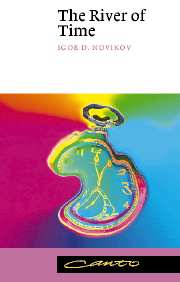Book contents
- Frontmatter
- Contents
- Preface to the Russian edition
- Preface to the English edition
- 1 Origins of thinking about time
- 2 Science of time is born
- 3 Light
- 4 The pace of time can be slowed down!
- 5 Time machine
- 6 Time, space and gravitation
- 7 Holes in space and time
- 8 Energy extracted from black holes
- 9 Towards the sources of the river of time
- 10 Journey to unusual depths
- 11 Grand Unification
- 12 Sources
- 13 What produces the flow of time and why in a single direction only?
- 14 Against the flow
- 15 Can we change the past?
- Conclusion
- Name index
- Subject index
7 - Holes in space and time
Published online by Cambridge University Press: 04 May 2010
- Frontmatter
- Contents
- Preface to the Russian edition
- Preface to the English edition
- 1 Origins of thinking about time
- 2 Science of time is born
- 3 Light
- 4 The pace of time can be slowed down!
- 5 Time machine
- 6 Time, space and gravitation
- 7 Holes in space and time
- 8 Energy extracted from black holes
- 9 Towards the sources of the river of time
- 10 Journey to unusual depths
- 11 Grand Unification
- 12 Sources
- 13 What produces the flow of time and why in a single direction only?
- 14 Against the flow
- 15 Can we change the past?
- Conclusion
- Name index
- Subject index
Summary
When I began to study general relativity seriously (which was in the late fifties), no one knew well what a black hole would be. Even the term itself did not appear in either strictly scientific or popular science publications. This is a stark contrast with what we see today, when almost everyone has read or at least heard about them. The black hole is a product of gigantic gravitational forces. Black holes are born when the gravitational field, growing in the course of catastrophic contraction of a very large mass of matter, becomes so strong that it ceases to let out anything, even light. An object can only fall into a black hole, pulled by its huge gravitational force, but there is simply no way out.
I first read a description of very strong gravitational fields in the Landau and Lifshitz monograph that I have already mentioned. I studied it while still a student, under Zelmanov's guidance. The book gave a very brief but extremely clear presentation of the properties of the gravitational field of a strongly compressed spherical mass. The solution of Einstein's equations for this case was found by the German astronomer Karl Schwarzschild; consequently, this gravitational field is known as the Schwarzschild field.
I remember that this subsection left me rather indifferent. Nevertheless, I did make some evaluations, using the formulas in the book and the knowledge gained from talking to Abram Zelmanov.
- Type
- Chapter
- Information
- The River of Time , pp. 95 - 138Publisher: Cambridge University PressPrint publication year: 2001

